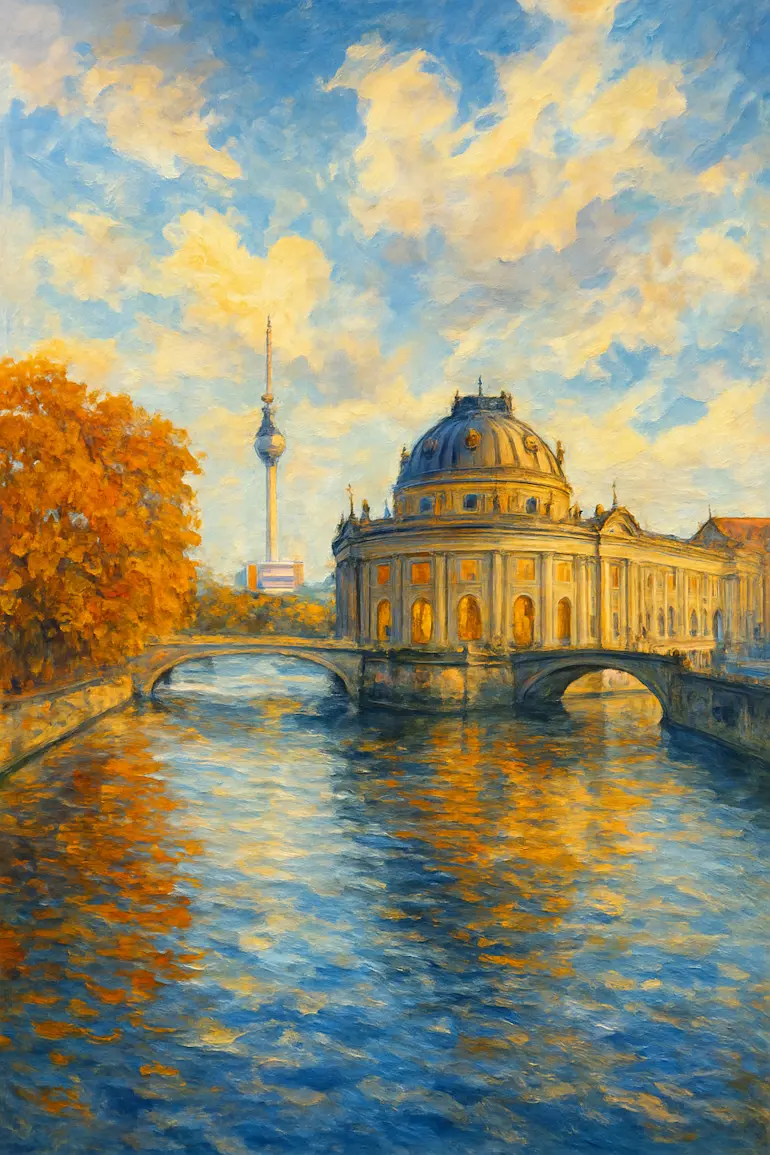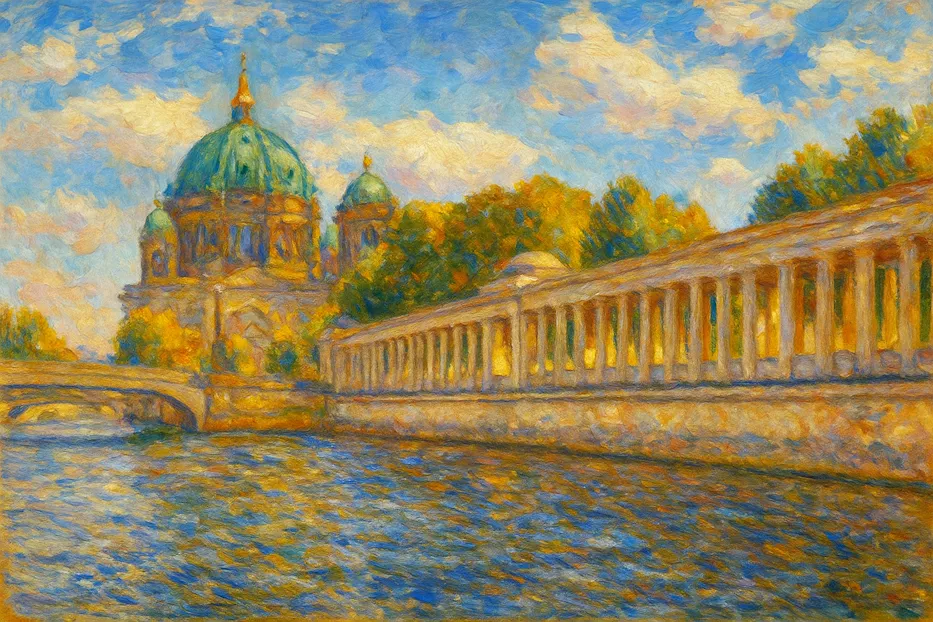If you’re in Berlin and looking for a spot that has it all—history, art, and jaw-dropping architecture—Museum Island is the place to be.
In the heart of Berlin, embraced by the Spree River and its canal, lies an island that is less about isolation and more about gathering — gathering of ideas, artifacts, architecture, memory. Museum Island (Museumsinsel) is more than a cluster of museums; it is an unfolding story of Germany—of Prussia, war, reconstruction, identity, and global cultural exchange. For travelers, historians, and art lovers, it offers an incomparable journey through time and civilizations.
Table of Contents
A Vision Rooted in Enlightenment
The roots of Museum Island reach back to the early 19th century, when the ideals of the Enlightenment—public education, the cultivation of knowledge, the democratizing of art—were translating into real civic institutions. After the Napoleonic Wars, when art was looted and later returned to Prussia, there was a renewed commitment among Prussian rulers to not simply restore what was lost, but to create spaces that would make art and history accessible to the public. The Altes Museum (Old Museum), designed by Karl Friedrich Schinkel, was the first result of this thinking. Its foundation stone was laid in 1825, and by 1830 it opened as Berlin’s first museum building—yet more than that, it was a statement: art, antiquity, science, philosophy were part of the public sphere.
Over the next century, a further four museums would join: the Neues Museum (New Museum, mid-19th century), the Alte Nationalgalerie (Old National Gallery), the Bode Museum, and finally the Pergamon Museum, which opened in 1930. Each addition reflects changing aesthetic, political, and cultural priorities. The ensemble is not haphazard but thoughtfully built — both in terms of what is shown inside and how the buildings articulate with each other and with Berlin itself.
The Museums: Collections, Highlights, & Architectural Drama
Museum Island comprises five principal museums, plus a more recent addition—the James‐Simon‐Galerie, opened in 2019—as a visitor center and entrance hub. While the newer gallery offers modern visitor amenities, the five historic museums still tell the core stories.
Here is a brief tour:
Altes Museum: The oldest museum on the island. Its design is classicist, with a large rotunda inspired by ancient Roman and Greek architecture. Inside, visitors encounter collections of classical antiquity—Greek, Roman, Etruscan sculptures; coins; jewellery. It was meant to showcase the royal collection but also to serve as public education. The building itself, with its sweeping columns and grand steps, is a masterpiece of 19th-century museum building.
Neues Museum: Perhaps best known for the bust of Nefertiti, the Neues Museum blends ancient Egypt with prehistory, early history, and classical antiquity. It was badly damaged during WWII, left partially in ruins in East Berlin, then painstakingly restored by David Chipperfield in the early 2000s. The tension between ruin and restoration, old and new, is a central part of its appeal.
Alte Nationalgalerie (Old National Gallery): This building feels like a temple on a pedestal, rising with stately steps. It houses art from the period between the French Revolution and World War I: Romanticism, Impressionism, Biedermeier, early Modernism. Works by Caspar David Friedrich, Manet, Monet, Renoir appear here.
Bode Museum: Situated at the northern tip of the island, Bode offers sculpture, Byzantine art, coins (the Münzkabinett). Its style is more ornate, with domes and gallery spaces that display art from the Middle Ages through the 18th century.
Pergamon Museum: Perhaps the crowd favorite—and for good reason. With monumental reconstructions such as the Ishtar Gate from Babylon, portions of the Pergamon Altar, everything gigantic, everything evocative, everything transporting. The museum is undergoing renovation; it is partly closed until 2027, when key halls and highlights will reopen.
James Simon Gallery: The newest component, designed as a kind of gateway to the island. It serves as a reception and orientation space, helping visitors enter the complex and plan their itinerary among the older museums. Its architecture is a dialogue with the historic—modern yet respectful.
The Island as Witness: History, War, Division, Rebirth
Museum Island’s buildings and collections haven’t just been static backdrops; they’ve endured war, division, ideological shifts, and changing curations of memory.
During WWII many of the museums were damaged. The Neues Museum was heavily bombed, its interior gutted. After the war, Berlin’s division meant that the island fell into East Berlin jurisdiction. Resources for restoration were scarce, so while some repairs were made, full restoration had to wait.
After German reunification, a master plan to restore, renovate, and unify Museum Island was enacted. Since 1999 the ensemble has been a UNESCO World Heritage Site. Renovation efforts have included both structural repair and conceptual decisions about how the museums should serve a modern public: accessibility, visitor flow, interpretation, connection between museums. A key aim has been restoring architecture and collections to their rightful prominence while also ensuring the island is not a narrowly academic space, but one accessible, emotionally resonant, and relevant.
The island now embodies a kind of palimpsest: layers of Prussian ambition, war damage, Cold War divisions, and contemporary efforts to reconcile with the past. Even the buildings’ styles—neoclassical, Renaissance revival, Baroque revival—signal different eras of taste and power. That architectural variety is part of what made the site a UNESCO listing: it is not one style but many, arranged over more than a century, in service of one purpose.

Why It Matters: The Value for Berlin, for Visitors, for the World
Museum Island is not merely a tourist destination; it is a cultural, educational, political, and emotional touchstone.
Cultural Memory & Identity: For Germans, Museum Island is a repository of national identity, but also a space to wrestle with difficult history: colonial legacies, war, ideological divides. It is not uncritical.
Architectural Heritage: The buildings themselves are landmark works: Schinkel, Stüler, Ihne, Messel—the architects span generations. Walking among them, one sees the evolution of museum architecture: from temple-like neoclassicism, through romantic and revivalist styles, into the 20th century’s larger, more monumental spaces. The recent work (James Simon Gallery, renovation efforts) shows how that heritage can be preserved while adapting to modern museum needs.
Education & Scholarship: The collections are among the world’s most significant in many fields: Egyptology, classical antiquities, Byzantine art, prehistory, 19th-century painting. For scholars, curators, and students, the island is a resource. For general visitors, it’s a chance to see some of civilization’s high points—Nefertiti, Ishtar Gate, Pergamon Altar, Romantic landscapes, etc.
Tourism & Urban Life: The island draws millions of visitors each year: people come for the art, but stay for the architecture, riverside views, cafés, gardens. It contributes to Berlin’s identity as a city of culture. Also, its restoration and development have urban implications: improved visitor flow, public spaces, transport integration, accessibility. The opening of the U5 subway station “Museumsinsel” in 2021 is a case in point.
Practical Considerations for Visitors
To make the most of Museum Island, here are key tips based on current information:
Planning & Tickets: Because of ongoing renovations—especially in the Pergamon Museum (partial closures until 2027)—check ahead which halls and exhibits are open. Some works (e.g. highlight halls in Pergamon) are closed but will re-open.
Timings: Museums generally open at about 9:00 am, many close at 6:00 pm; some have extended hours on certain days. Note which are closed on Mondays.
Accessibility & Visitor Experience: Wheelchair access is mostly present; orientation aids for visually or hearing-impaired visitors are provided. The James Simon Gallery helps with visitor orientation. There is a “Colonnade Courtyard” which acts as a public space among the museums—good for rest, contemplation, or people-watching.
Getting There: The Island is centrally located. The Museumsinsel U-station (U5) opened 2021, providing direct access. Several S-bahn and bus lines also serve nearby stops.
Best Strategy: If time is limited, prioritize based on your interests: for classical antiquity, head to Neues or Pergamon; for romantic/modern art, Alte Nationalgalerie; for sculpture and coins, Bode; for architectural sweep and historical interpretation, Altes Museum and the James Simon Gallery.
Challenges & Debates
No cultural institution of this scale escapes controversy or debate. Museum Island too faces a number of tensions:
Restoration vs. Original Fabric: How to balance historical authenticity with modern functional demands. Some buildings suffered severe war damage; restoration work necessarily involves interpretive decisions.
Colonial Legacies & Repatriation: Some collections, especially from Ancient Near East or non-European cultures, raise questions about provenance, colonial acquisition, and whether certain artifacts should be returned. The bust of Nefertiti, for example, has been at the center of debate.
Visitor Pressure & Sustainability: With millions visiting, managing footfall, wear and tear, climate control, conservation is expensive and complex. Ensuring that visitor experience remains high while protecting fragile works is always a balancing act.
Inclusivity & Interpretation: How museums present history, whose voices are heard, what contexts are provided—these are increasingly important. Museums are not just about displaying objects, but framing stories. The island’s restorations and curation shifts increasingly reflect this.
Looking Forward
Museum Island is not static. Several projects under the Master Plan are underway or planned, designed to knit the museums more tightly together, improve visitor circulation, upgrade infrastructure, and enhance public engagement.
One significant future highlight is the reopening of more of the Pergamon Museum; from 2027, key sections will once again be accessible. There is also a vision of connecting the museums via underground ramps or promenades (the “Archaeological Promenade”) to ensure smoother flows between buildings.
There is also a cultural shift: Museum Island is increasingly seen not just as a custodian of Germany’s past, but part of global dialogues—about restitution, about migration, about shared heritage. In that, its role may continue to grow—not merely as a site of display, but as a space for contemporary reflection.
What Museum Island Offers You
For any visitor, Museum Island delivers more than museums: it delivers experience.
Physical experience: Walking through varied spaces—grand halls, intimate rooms, restored ruins—is moving. The architecture envelops you.
Historical span: From Egyptian antiquities, through Greco-Roman ruins, through Romantic landscapes and impressionist art, up through early Modernism—you can traverse millennia.
Cultural reflection: You don’t just see objects; you see how art, power, identity, memory intersect. You see how Berlin has been shaped by war, division, reunification, by its role in colonialism and in modern German identity.
Aesthetic delight: Light, space, sculpture, ornament, gardens, views of the river—all contribute. Even if you don’t go inside every museum, the ensemble, the façades, the terraces, the courtyards are evocative.
GERMANY FERRY TICKETS
Exploring Museum Island
Museum Island stands as one of Europe’s great museum complexes. It is a place where time is layered, where architecture and art frame each other, where cultural memory is both preserved and questioned. Whether you come as a scholar, a tourist, an art-lover, or someone curious about history, it offers richness. Yes, restoration continues, and debates continue—and that is part of its vitality, not drawback.
In exploring Museum Island, you explore Berlin itself: its ambitions, its crises, its recovery, its ongoing conversation with its past and its place in the world. If you leave with fewer concrete answers than you had questions, that is perhaps exactly what this island intends.

